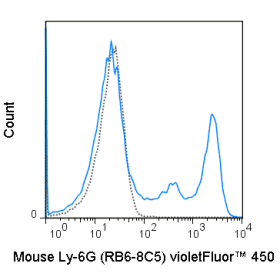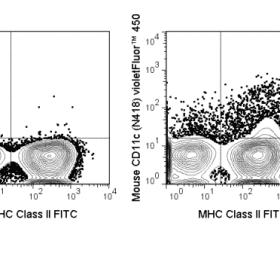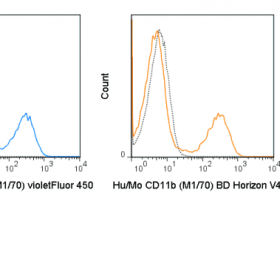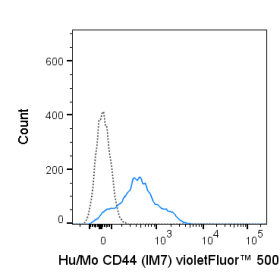Product Description
| Cat No. | Size | Price |
|---|---|---|
| 50-0031-U025 | 25 µg | $19.00 |
| 50-0031-U100 | 100 µg | $55.00 |
| 50-0031-U500 | 500 µg | $199.00 |
Description
The 145-2C11 antibody is specific for mouse CD3e, also known as CD3 epsilon, a 20 kDa subunit of the T cell receptor complex, along with CD3 gamma and CD3 delta. These integral membrane protein chains assemble with additional chains of the T cell receptor (TCR), as well as CD3 zeta chain, to form the T cell receptor – CD3 complex. Together with co-receptors CD4 or CD8, the complex serves to recognize antigens bound to MHC molecules on antigen-presenting cells. Such interactions promote T cell receptor signaling (T cell activation) and can result in a number of cellular responses including proliferation, differentiation, production of cytokines or activation-induced cell death. CD3 is differentially expressed during thymocyte-to-T cell development and on all mature T cells.
The 145-2C11 antibody is a widely used phenotypic marker for mouse T cells. In addition, binding of 145-2C11 antibody to CD3e can induce cell activation. A recent publication of the crystal structure of a murine CD3e-mitogenic antibody complex provides further insight into the action of commonly used agonist antibodies (Fernandes, R.A. et al. 2012. J. Biol. Chem. 287: 13324-13335).
Product Details
| Name | PE Anti-Mouse CD3e (145-2C11) |
|---|---|
| Cat. No. | 50-0031 |
| Alternative Names | CD3 epsilon |
| Gene ID | 12501 |
| Clone | 145-2C11 |
| Isotype | Armenian Hamster IgG |
| Reactivity | Mouse |
| Cross Reactivity | |
| Format | PE |
| Application | Flow Cytometry |
| Citations* | Staehli R, Ludigs K, Heinz LX, Sequin-Estevez Q, Ferero I, Braun M, Schroder K, Rebsamen M, Tardivel A, Mattmann C, MacDonald HR, Romero P, Reith W, Guarda G, and Tschopp J. 2012. J. Immunol. 188: 3820-3828. (in vitro activation)
Todo T, Wu G, Chai NN, He Y, Martins G, Gupta A, Fair J, Liu NY, Jordan S, and Klein A. 2012. Int. Immunol. 10:1093. (in vivo assay) Mira E, Leon B, Barber DF, Jimenez-Baranda S, Goya I, Almonacid L, Marquez G, Zaballos A, Martinez C, Stein JV, Ardavin C and Manes S. 2012. J. Immunol. 181(5): 3524-3534. (in vitro activation, Immunohistochemistry – frozen tissue) Becker-Herman A, Meyer-Bahlburg A, Schwartz MA, Jackson SW, Hudkins KL, Liu C, Sather BD, Khim S, Liggitt D, Song W, Silverman GJ, Alpers CE and Rawlings DJ. 2011. J. Exp. Med. 208:2033-2042. (Immunofluorescence microscopy – OCT embedded frozen tissue) Salmond RJ, Filby A, Pirinen N, Magee AI, and Zamoyska R. 2010. Blood. 117: 108-117. (Immunoprecipitation) Tilley SL, Jaradat M, Stapleton C, Dixon D, Hua X, Erikson CJ,. McCaskill JG, Chason KD, Liao G, Jania L, Koller BH, and Jetten AM. 2007. J. Immunol. 178: 3208-18. (Immunohistochemistry – frozen tissue) Isakov N, Wange RL, Burgess WH, Watts JD, Aebersold R, and Samelson LE. 1995. J. Exp. Med. 181:375-380. (in vitro activation, Immunoprecipitation) Salvadori S, Gansbacher B, Pizzimenti AM, and Zier KS. 1994. J. Immunol. 153: 5176 – 5182. (Western Blotting) Leo O, Foo M, Sachs D, Samuelson L, and Bluestone J. 1987. Proc. Natl. Acad. Sci. USA. 84: 1374 (Origination of clone 145-2C11, in vitro activation, in vitro blocking, Immunoprecipitation) |
Application Key:FC = Flow Cytometry; FA = Functional Assays; ELISA = Enzyme-Linked Immunosorbent Assay; ICC = Immunocytochemistry; IF = Immunofluorescence Microscopy; IHC = Immunohistochemistry; IHC-F = Immunohistochemistry, Frozen Tissue; IHC-P = Immunohistochemistry, Paraffin-Embedded Tissue; IP = Immunoprecipitation; WB = Western Blot; EM = Electron Microscopy
*Tonbo Biosciences tests all antibodies by flow cytometry. Citations are provided as a resource for additional applications that have not been validated by Tonbo Biosciences. Please choose the appropriate format for each application and consult the Materials and Methods section for additional details about the use of any product in these publications.
[accordions]
[accordion title=”Protocols”]Technical D ate Sheet[/accordion]














